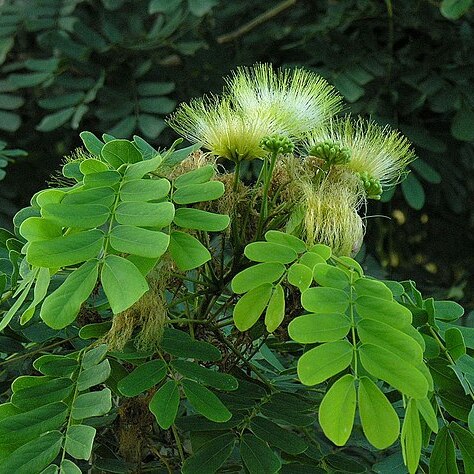Tree (1.5–)6–18 m. high; branches spreading; bark rough, reticulate.. Young branchlets glabrous or nearly so, or very shortly pubescent.. Leaves: rhachis glabrous or subglabrous; pinnae (1–)2–3(–4) pairs; leaflets 4–8 (–9) pairs, oblique, ovate to rhombic-ovate or elliptic-oblong (15–)23–50 (–63) mm. long, (7–)11–25(–41) mm. wide, rounded or slightly emarginate at apex, glabrous, papery to subcoriaceous, venose, very glaucous beneath.. Flowers greenish-yellow, ochre when over, with whitish filaments; flowers sessile or up to 2 mm. pedicellate; bracteoles already fallen by flowering time, minute, up to 1.7 mm. long.. Calyx (3–)3.5–5.5 mm. long, rather densely puberulous or minutely pubescent outside, not slit unilaterally.. Corolla (5–)5.5–11 mm. long, densely minutely appressed-pubescent outside.. Staminal tube not or scarcely exserted beyond corolla; filaments about 1.5–3 cm. long.. Pod oblong, 12–23 cm. long, 2.7–4.4 cm. wide, glabrous except for some hairs near base and near margins, slightly venose, ± transversely plicate, thin, usually pale brown.. Seeds about 7–9 mm. in diameter, flattened.
Leaves rhachis glabrous or subglabrous; pinnae 1-3(4) pairs, leaflets 4-8(9) pairs (15)23-50(68) x (7)11-25(41) mm., oblique, ovate to rhombic-ovate or elhptic-oblong, usually rounded or slightly emarginate at the apex, glabrous, papery to subconaceous, venose, very glaucous and often pale-grey beneath.
A shrub or small climbing tree. The leaves are twice divided. They are divided into 2-3 opposite pairs and these are then divided into 4-8 pairs of leaflets. The leaflets are oblong and at an angle. The pods are oblong.
Flowers greenish-yellow, ochre when over, with whitish filaments, sessile or up to 2 mm. pedicellate, bracteoles already fallen by flowering time, minute, up to 1.7 mm. long.
Pod dehiscent, 12-23 x 2.7-4.6 cm., oblong, glabrous except for some hairs near the base and margins, slightly venose, ± transversely plicate, thin, usually pale-brown.
Tree (1.5)6-18 in high; bark rough, or sometimes smooth, reticulate; branches spreading; young oranchlets glabrous or nearly so, or very shortly pubescent.
Calyx (3)3.5-5.5 mm. long, rather densely puberulous or minutely pubescent outside, not slit umlaterally.
Staminal tube not or scarcely exserted beyond the corolla, filaments c. 1.5-3 cm. long.
Corolla (5)5.5-11 mm. long, densely minutely appressed-pubescent outside.
Seeds c. 7-9 mm. in diam., flattened.


